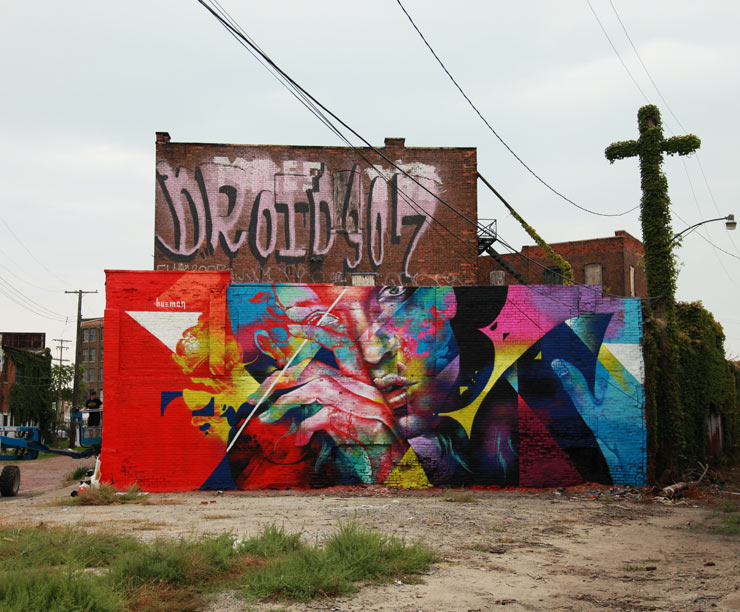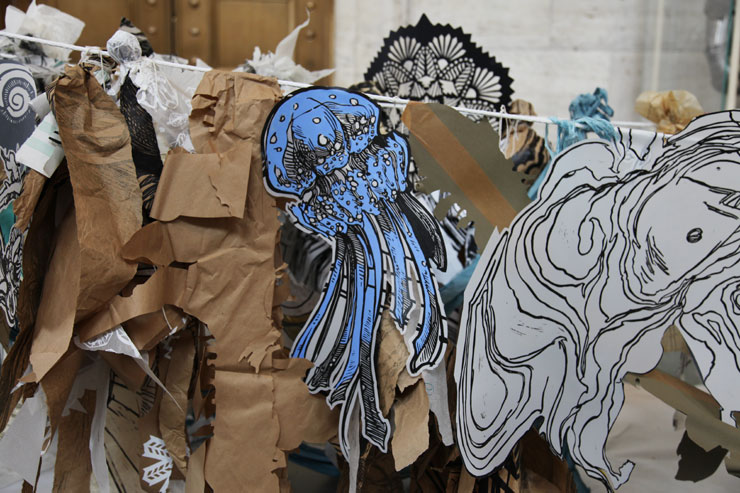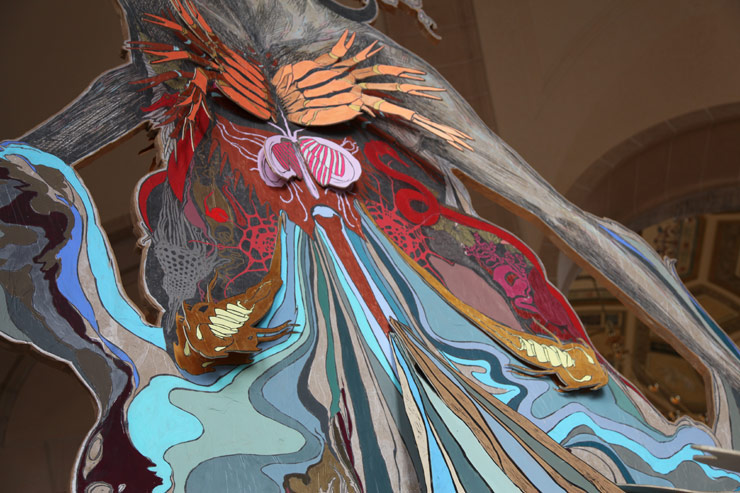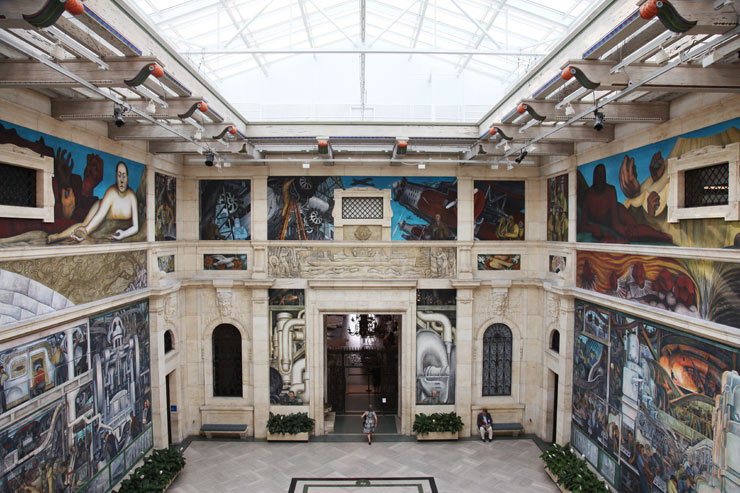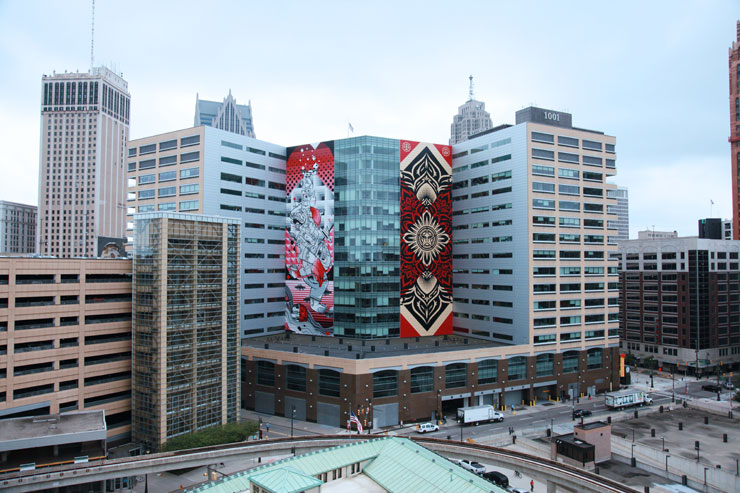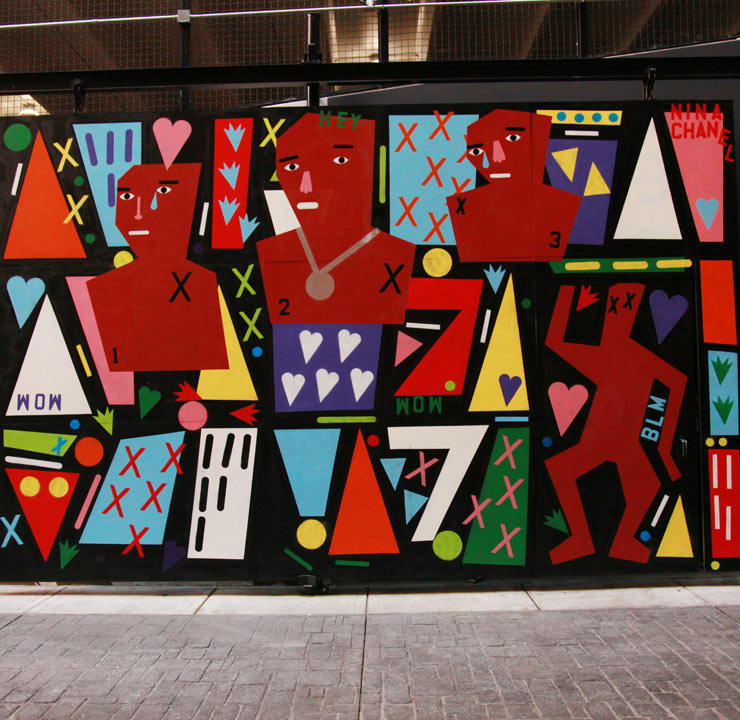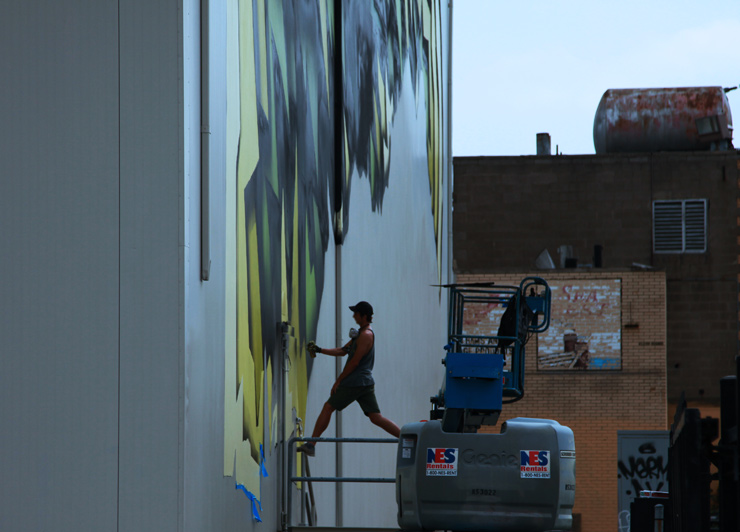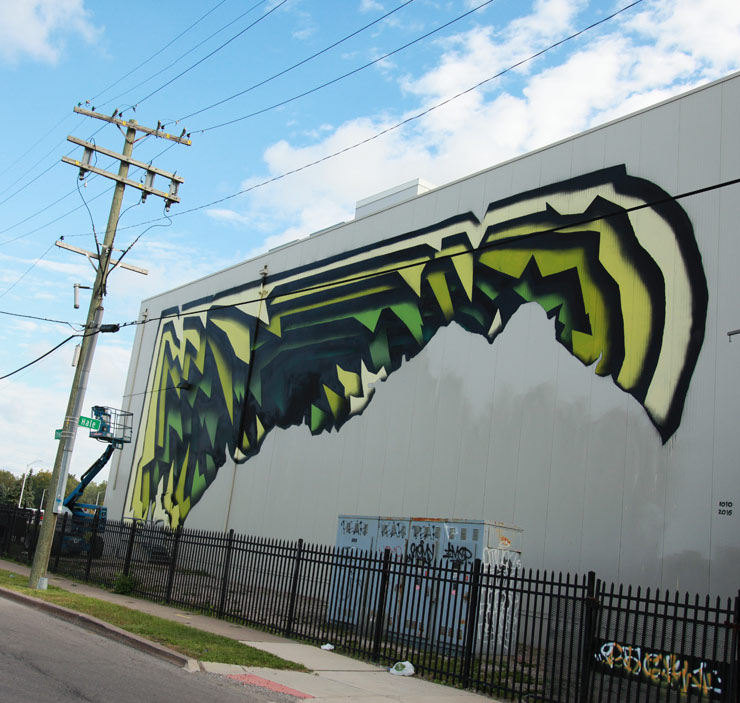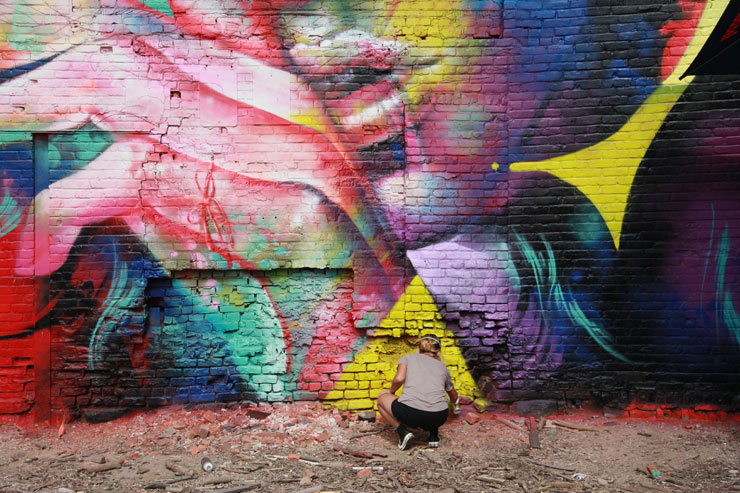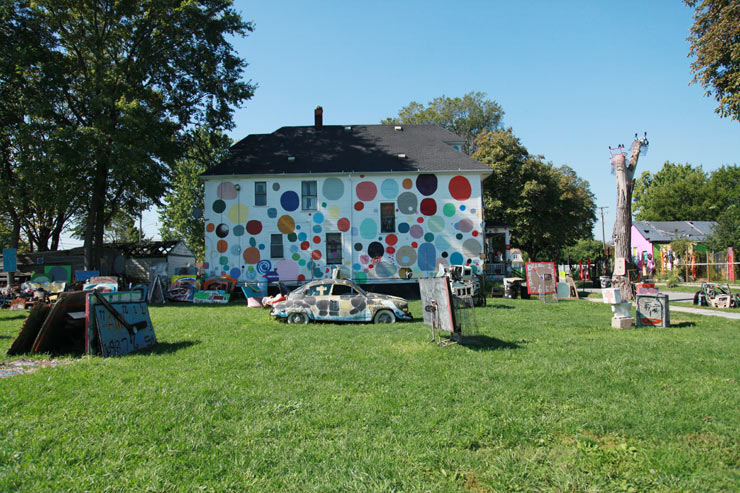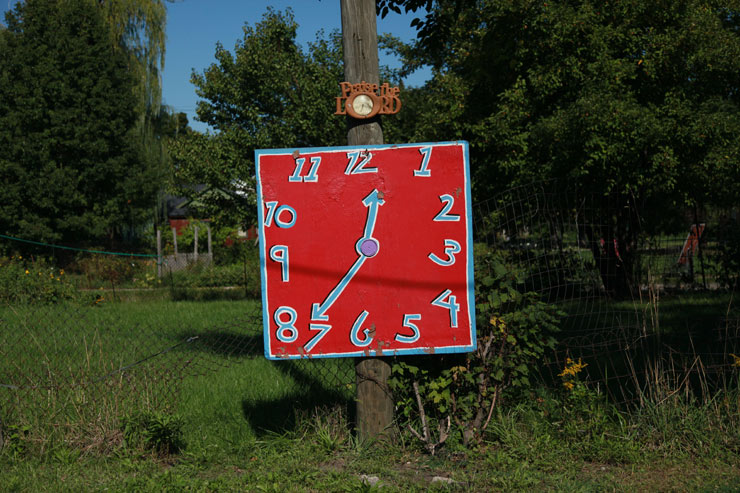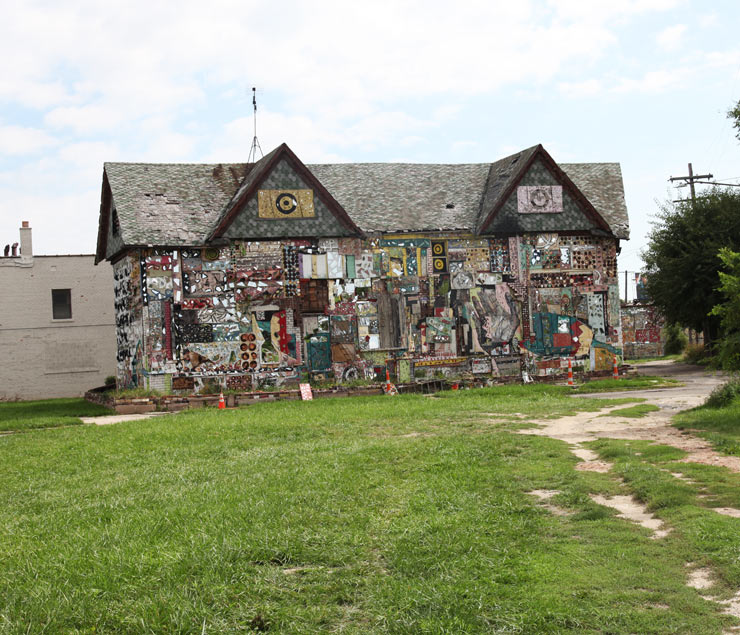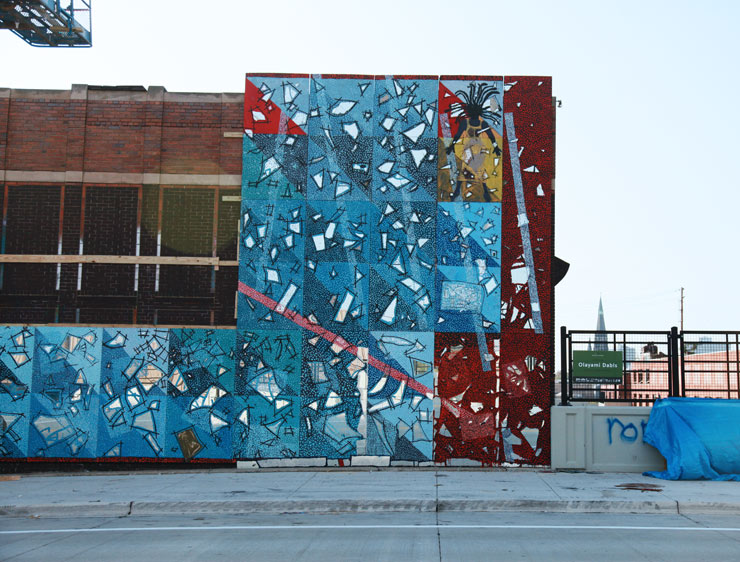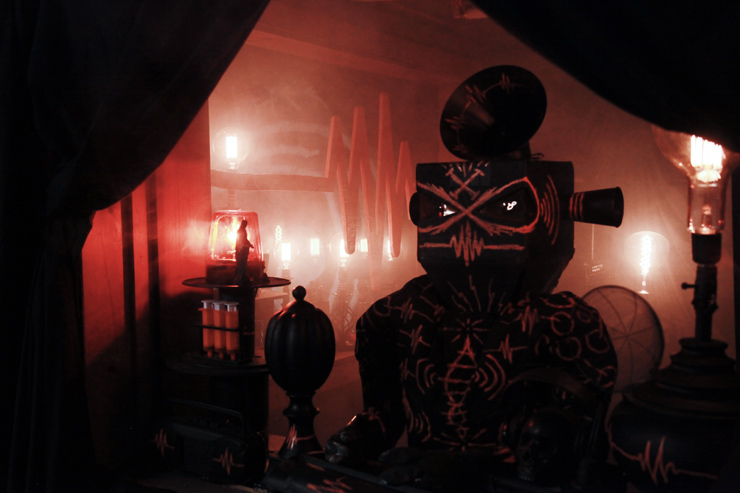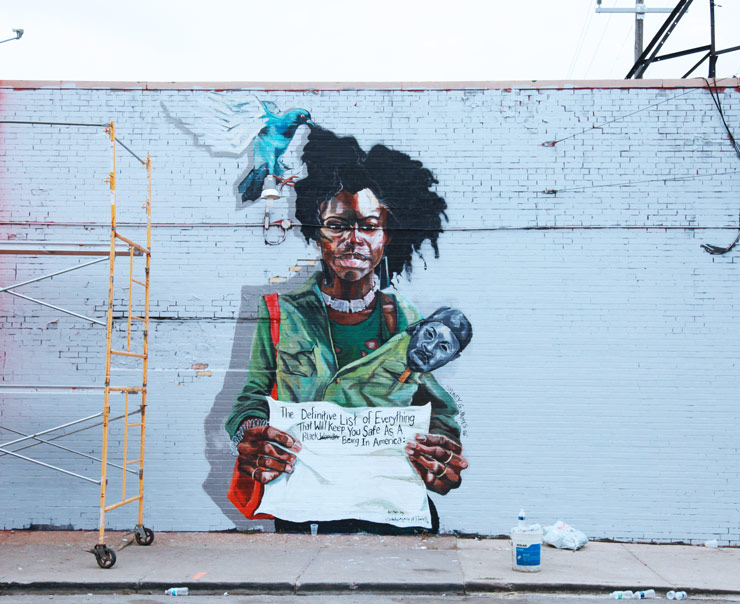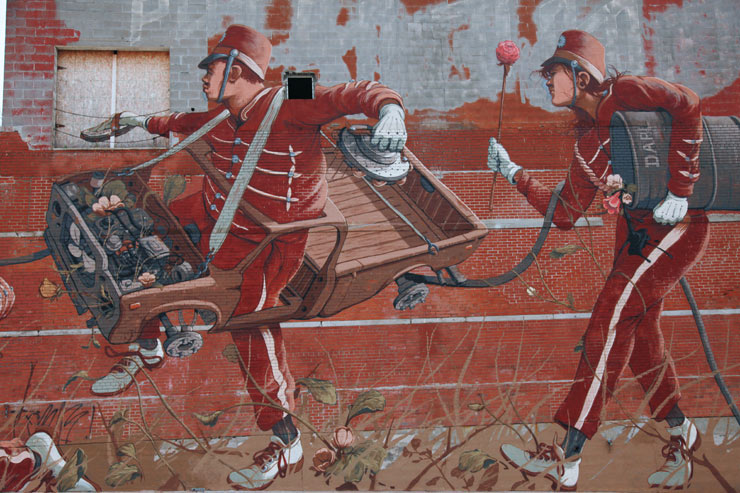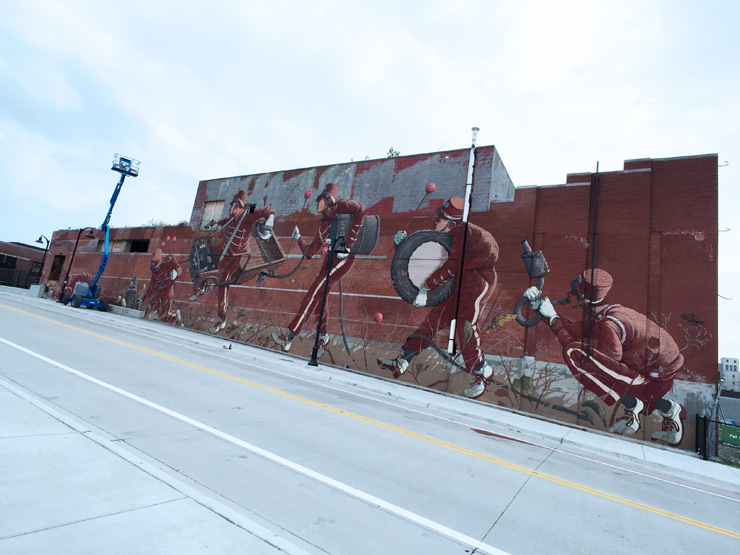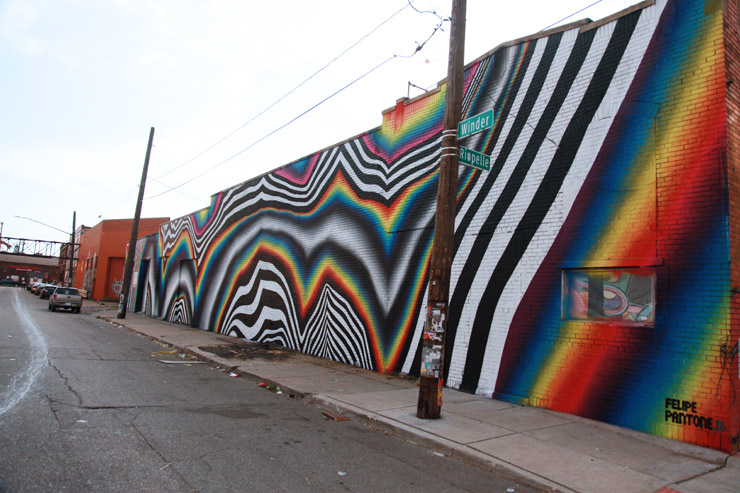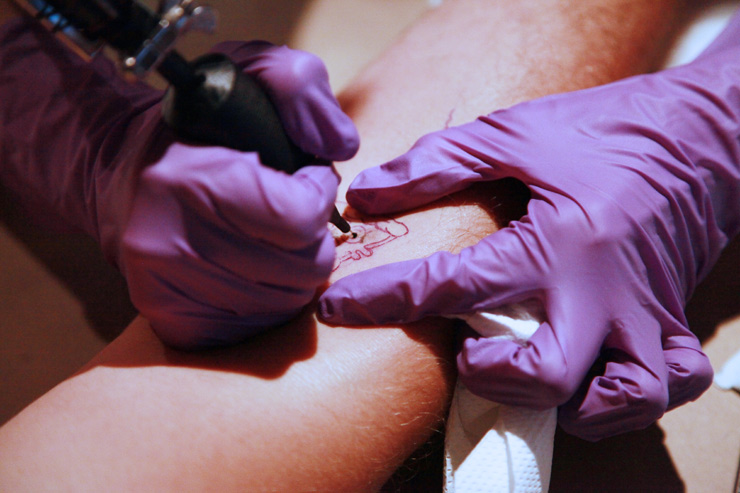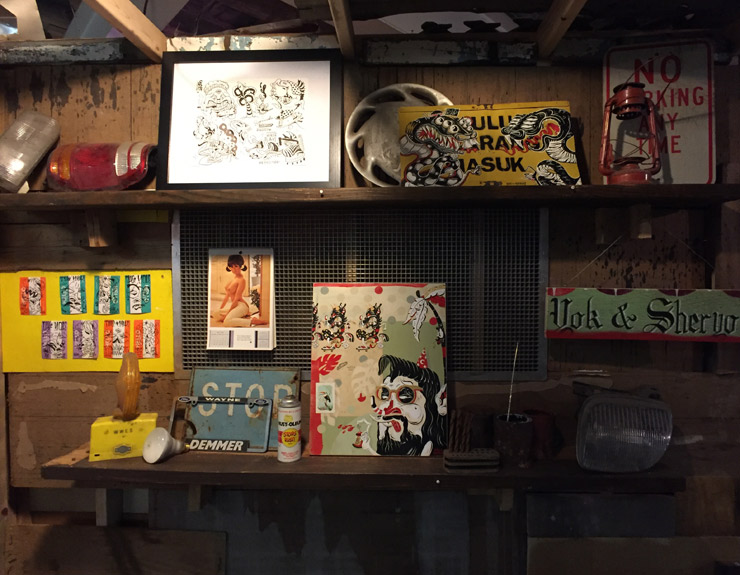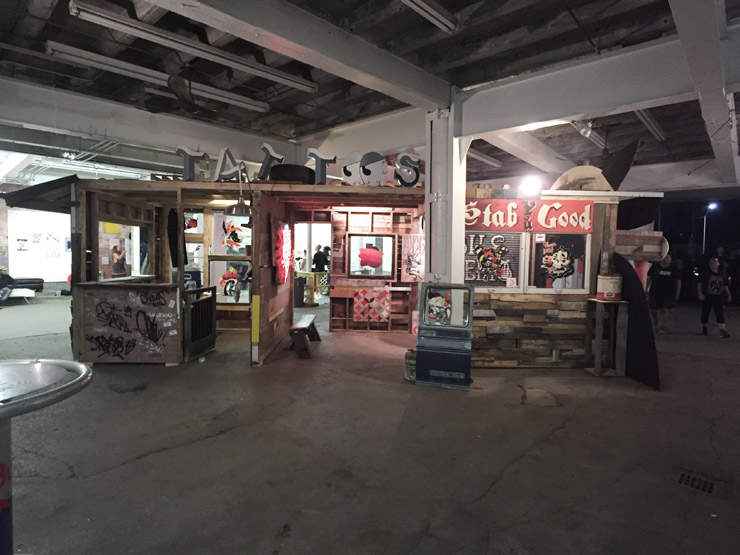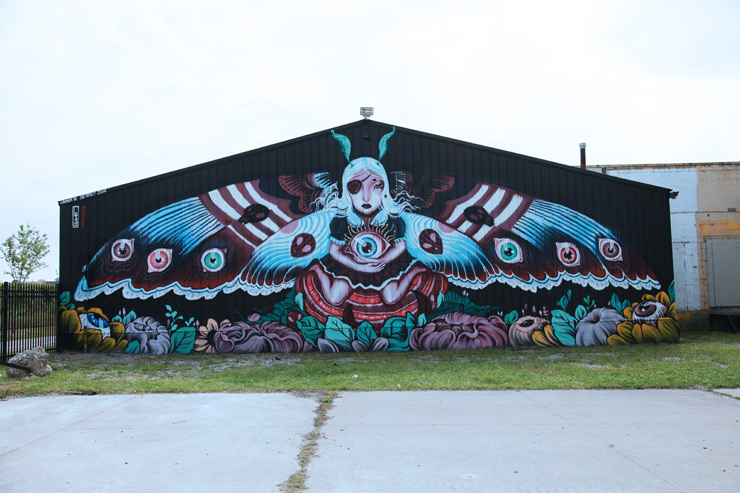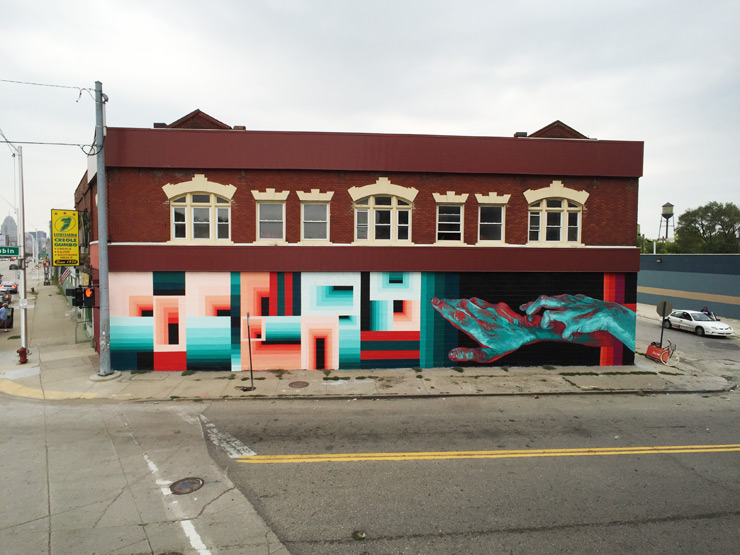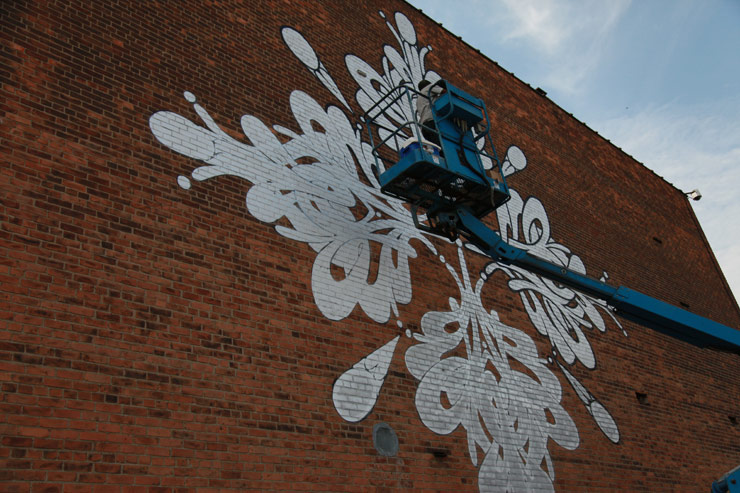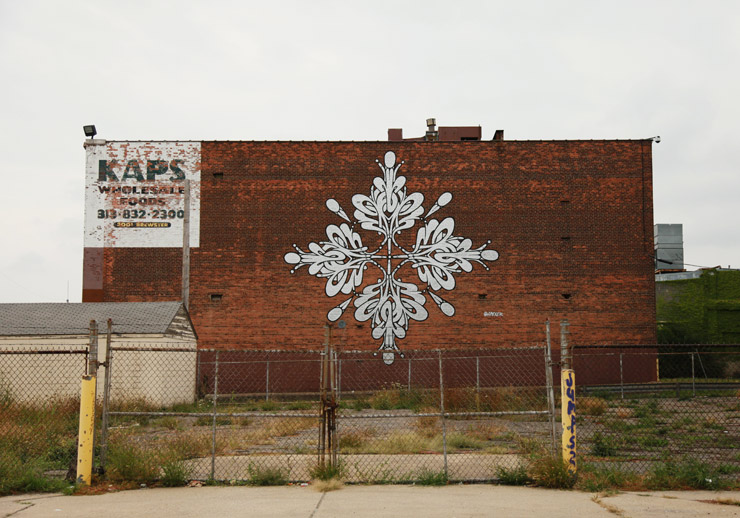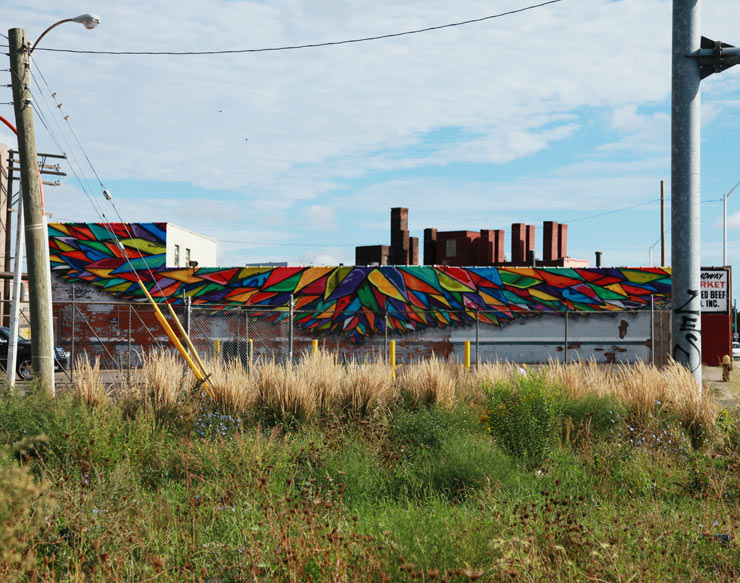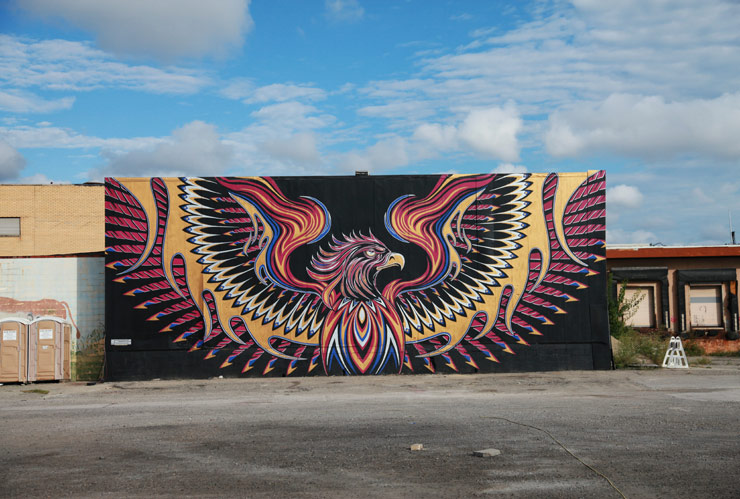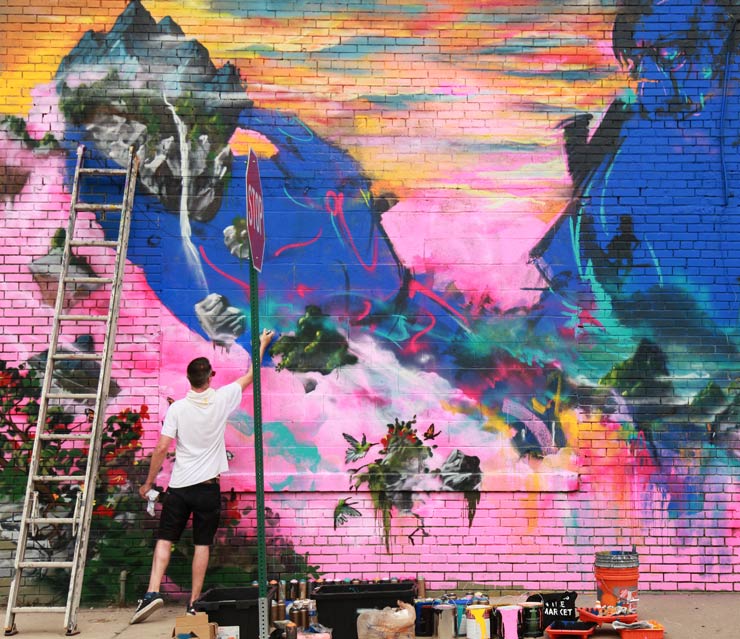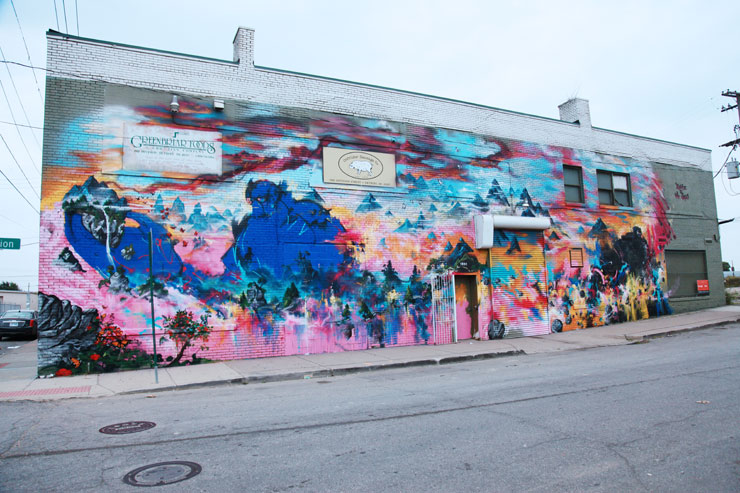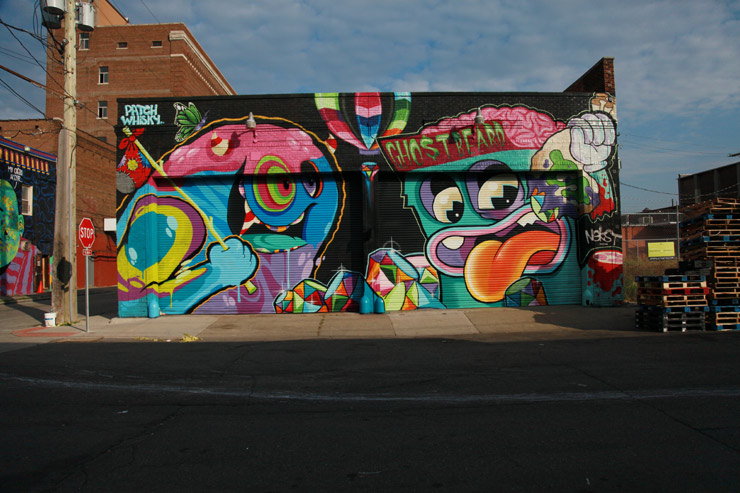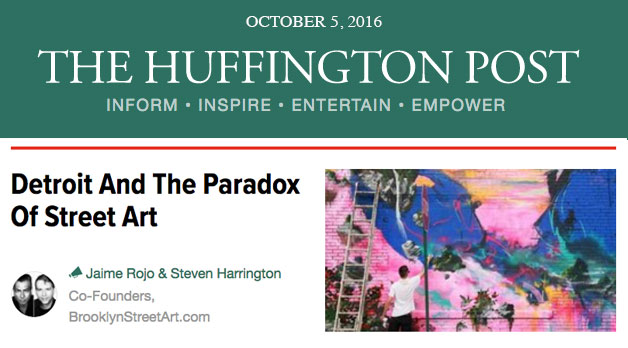Running through many of the streets fanning from Detroit’s’ downtown will lead you to a graffiti scene that gave birth to the large murals being celebrated in the city center. It is a cognitive dissonance for many at this moment when Detroit’s Mayor Mike Duggan’s name comes into conversation as making political hay by targeting Street Artists – especially while that same genre is employed to brandish the creative vitality of a financially bankrupted yet proud American powerhouse like the Motor City.
Detroit, Michigan. (photo © Jaime Rojo)
Here in the dank darkened hallways of former factories and warehouses that once pumped life through an economy lies some of the DNA that can grow a creative resurgence. These property owners may have abandoned the citizenry and taxpayer and the bond of their promise to honor community, and that charge is often made as wide swaths of people are without work or pensions or viable social mobility. Technically these property owners would be entitled to prosecute the artists and taggers for vandalism – but many have skipped town with the wealth they gained here and left the city to deal with these architectural carcasses.
Detroit, Michigan. (photo © Jaime Rojo)
Contemplate now with us the intersection of illegal art-making crossing paths with celebrated cultural recognition and commercial reward. It is a fiery collision of intertwined ironies. The Street Art paradox in Detroit and elsewhere is that the work of vandals eventually becomes celebrated by greater society, but until then you should look over your shoulder.
This is the city where Shepard Fairey was threatened with a 10-year jail sentence and simultaneously feted for his soaring murals. With a new director/ president/ CEO who is the same age as Fairey, the Detroit Institute of Arts (DIA) is currently unveiling a new installation by Brooklyn Street Artist Swoon in the entryway of the Beaux-Arts building’s Woodward Avenue. During the installation Salvador Salort-Pons walks with Swoon through hundreds of pieces of hand-cut paper and linoprint that are spread across the tiled floors discussing logistics.
Swoon. Thalassa installation in progress at the Detroit Institute of Art. Detroit, Michigan. (photo © Jaime Rojo)
Her character Thalassa is suspended high where a chandelier had hung and as you gaze upward you may wonder how many museum goers will know that Swoon began her career by illegally pasting papercut works and characters like Thalassa on the street in the late 1990s Brooklyn, risking arrest and prosecution.
Swoon. Thalassa installation in progress at the Detroit Institute of Art. Detroit, Michigan. (photo © Jaime Rojo)
As we speak with Callie Curry, the artist known as Swoon, she marvels aloud that her work is hanging very near Rivera Court, a collection of 27 frescoes by the socialist-themed Mexican muralist Diego Rivera – which are now officially national historic landmarks. Her work in recent years has been featured in larger and more prominent institutions from the Venice Biennale to the Brooklyn Museum and LA MOCA’s “Art in the Streets” exhibition in 2011 in Los Angeles. For most Street Artists in their teens and 20s like Swoon was when she was doing illegal work, gallery doors are closed, let alone museum doors. The streets are the gallery and a petri dish for experimentation and engaging with the public.
Diego Rivera. Detail. Detroit Institute of Art. Detroit, Michigan. (photo © Jaime Rojo)
At the opposite end of the illegal spectrum are real estate interests who are actively inviting Street Artists to paint on their walls, like the multi-story twin pieces by Fairey and the German graffiti-writing train-tagging vandal brothers How & Nosm. 30 plus artists, many of them previous/current vandals were invited to paint inside the a vertical parking garage name Z and the alleyway adjacent to it in Downtown Detroit. We can cite cities and towns and real estate developers and business improvement districts who are seeking out these artists to activate public space in places like Miami, Philadelphia, New York, London, Lodz, Rio de Janeiro, Hong Kong, Dubai, and New Delhi, among others.
How & Nosm and Shepard Fairey for Library Street Collective. Detroit, Michigan. (photo © Jaime Rojo)
The Library Street Collective in downtown Detroit, whose founder Anthony Curis is a big supporter of DIA and who will host a gallery show opening October 8th with Swoon as well, is facilitating a public mural for her to paint legally. It is sort of an open secret that the majority of these artists on the Library Street Collective roster ran the streets doing illegal work on trains and public and privately owned walls and would have been pursued by real estate interests years ago for other reasons that include handcuffs. Most will tell you that they used the streets and street culture to hone their skills, and truthfully it is a fact that adds to their street cred and saleability among certain collectors.
The newest mural for Library Street Collective is by a non-Street Artist, Nina Chanel. It references the Black Lives Matter movement and the targeting of African American men in the country. Detroit, Michigan. (photo © Jaime Rojo)
So here’s the message Street Artists are getting – don’t expect any institutional, academic or commercial support or nurturing of your talent or skills or craft. You are on your own. In fact you will be demonized and reviled and pursued and dealt with punitively. If, through the help of other artists and cultural workers in the graffiti and Street Art community and some serious luck, you can still persist and become marketable, your work will be recognized as worthwhile and rewarded.
Cultivate, no. Harvest, yes.
In the case of New York train writers from the late 1970s like Futura, you may still need to be a bicycle messenger through Manhattan streets dodging taxis and Town cars for many years to pay your rent and support your family before commercial and institutional support actually rewards your talent. In the case of the majority of graffiti and Street Artists, that opportunity has yet to arrive, and may not.
1010 for Murals In The Market 2016. Detroit, Michigan. (photo © Jaime Rojo)
One model of commercial and community support that is bridging the gap between the streets, artists, collectors, and the people who live and work in Detroit is the second annual “Murals in the Market” festival that is just completed. Originated by a local business couple named Roula David who serves as the festival’s director and Jesse Cory, who with Dan Armand founded a successful online art print business called 1xRUN. Ms. Roula and Mr. Cory also run the bricks-and-mortar gallery called Inner State. Working with neighborhood associations and businesses, the festival is supported by grants, local businesses, and the pairs’ personal investment.
1010 for Murals In The Market 2016. Detroit, Michigan. (photo © Jaime Rojo)
The open air Eastern Market has a bustling, even booming, reputation for fostering fresh lifeblood of economic activity that supports local fresh organic farmers, makers, artisans, restaurants, families, and football tailgaters. This year about 50 local and international graffiti and Street Artists painted walls of factories and warehouses with impunity, and with maps given for finding the locations. Local galleries and businesses and only a few national brands, like an energy drink maker who sponsors artists with residencies, all provided a wild night of performances and art shows for a few thousand fans who swarmed the streets looking at and posing with art and their friends.
Hueman for Murals In The Market 2016. Detroit, Michigan. (photo © Jaime Rojo)
Hueman for Murals In The Market 2016. Detroit, Michigan. The DROID 907 tag above was not in collaboration with the Hueman or Murals In The Market. (photo © Jaime Rojo)
The talents draw across disciplines, with great variations in approach, background, history, influences, and ability. With so many people walking the map route to see and engage with the works, a common comment was “why do I need to go to a museum when I can see this for free on the street?” They may also meet the artist in person.
With precious little governmental support for arts these days and at programs in public schools often cut out entirely in the US, many of these artists who began on the streets say they were pleased to participate in some formal program and to have an opportunity to show their work without fear of reprisal. They also showed fine art works in the crowded gallery show and heard presentations from photographers and designers who were deeply involved in the early punk and hip-hop scenes that rose in parallel with graffiti and Street Art.
Tyree Guyton. A three decade environmental art project in Detroit called The Heildeberg Project. Detroit, Michigan. (photo © Jaime Rojo)
Tyree Guyton. Heildeberg Project. Detroit, Michigan. (photo © Jaime Rojo)
David and Cory routinely host talks and special events at Inner State and they allow it to be used by local design entrepreneurs and planners to host their own openings or meetings. Corey says they have worked hard to be inclusionary rather than exclusionary: fostering connections to important cultural contributors like the pioneering Detroit outdoor environmental artists Trey Guyton of The Heidelberg Project and Olayami Dabls with his Mbad African Bead Museum. In fact, both of these artists are featured artists in this years Murals in the Market.
Olayami Dabls. Detroit, Michigan. (photo © Jaime Rojo)
Olayami Dabls for Murals In The Market 2016. Installation process shot. Detroit, Michigan. (photo © Jaime Rojo)
Additionally, the Murals in the Market scene commingled this week at a ‘Detroit Family Reunion’ bonfire, barbecue, and screening of “WastedLand 2” by filmmaker Andrew Shirley at Lincoln Street Art Park, which lies adjacent to a grassroots recycling center called Recycle Here! Shirley also curated the two-floor warehouse exhibition that pairs the wild untamed raw-graff artistry of the primarily New York based 907 Crew and a group of local Detroit graffiti kings who sprayed fresh elaborate show pieces side by side.
EKG. Detail. WASTEDLAND in conjunction with Murals In The Market 2016. Detroit, Michigan. (photo © Jaime Rojo)
Collectively this alchemy of Murals in the Market and the active Graff/Street Art scene is precisely what is needed and what the artists and their admirers deserve. It is an inclusionary model that recognizes, nurtures and preserves the antecedents of the current global Street Art scene. It also lets young people in their teens and twenties know that this is an evolving artist community that is alive and dynamic – not a collection of dead people who they cannot relate to. If you look for it, you can see that the street is presenting a collective voice that is sometimes transgressive and draws upon the challenged communities living in these United States of Anxiety. Often there are the seeds of promise.
Sydney G. James for Murals In The Market 2016. Detroit, Michigan. (photo © Jaime Rojo)
Museums and other institutions are missing a huge opportunity to engage with young audiences by ignoring these constituencies, and we encourage a kind of whole-hearted curatorial risk-taking that acknowledges the fuzzy grey areas and attempts to salvage the pertinent contributions of an active creative class. In our travels and writings and curatorial endeavors we have seen the promise and the talent. The work needs to be considered in a manner that far exceeds the calculation of its perceived market value – much of this work opens doors to our collective creative future.
As ever, when it comes to big name shows, institutional recognition, commercial adaptation, community-based efforts, and on-the-margins badassery, one can often find compelling reasons to love the continuum of Street Art / graffiti and their many tributaries and trajectories.
Pat Perry. Detail. Murals In The Market 2016. Detroit, Michigan. (photo © Jaime Rojo)
Pat Perry for Murals In The Market 2016. Detroit, Michigan. (photo © Jaime Rojo)
Greg Mike for Murals In The Market 2016. Detroit, Michigan. (photo © Jaime Rojo)
Greg Mike for Murals In The Market 2016. Detroit, Michigan. (photo © Jaime Rojo)
Pixel Pancho for Murals In The Market 2016. Detroit, Michigan. (photo © Jaime Rojo)
Felipe Pantone for Murals In The Market 2016. Detroit, Michigan. (photo © Jaime Rojo)
Sheryo for Murals In The Market 2016. Detroit, Michigan. (photo © Jaime Rojo)
Sheryo and The Yok for Murals In The Market 2016. Detroit, Michigan. (photo © Jaime Rojo)
Sheryo and The Yok for Murals In The Market 2016. Detroit, Michigan. (photo © Jaime Rojo)
Lauren YS and Ouizi for Murals In The Market 2016. Detroit, Michigan. (photo © Jaime Rojo)
Dalek and Taylor White for Murals In The Market 2016. Detroit, Michigan. (photo © Jaime Rojo)
Apexer for Murals In The Market 2016. Detroit, Michigan. (photo © Jaime Rojo)
Apexer for Murals In The Market 2016. Detroit, Michigan. (photo © Jaime Rojo)
Apexer for Murals In The Market 2016. Detroit, Michigan. (photo © Jaime Rojo)
Chris Saunders for Murals In The Market 2016. Detroit, Michigan. (photo © Jaime Rojo)
Mr. Jago and Xenz for Murals In The Market 2016. Detroit, Michigan. (photo © Jaime Rojo)
Mr. Jago and Xenz for Murals In The Market 2016. Detroit, Michigan. (photo © Jaime Rojo)
Patch Whisky and Ghostbeard for Murals In The Market 2016. Detroit, Michigan. (photo © Jaime Rojo)
This article is also published on The Huffington Post
 BROOKLYN STREET ART LOVES YOU MORE EVERY DAY
BROOKLYN STREET ART LOVES YOU MORE EVERY DAY